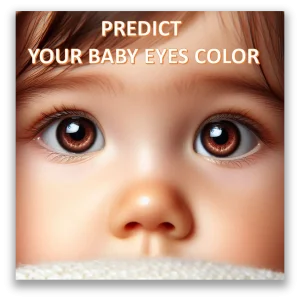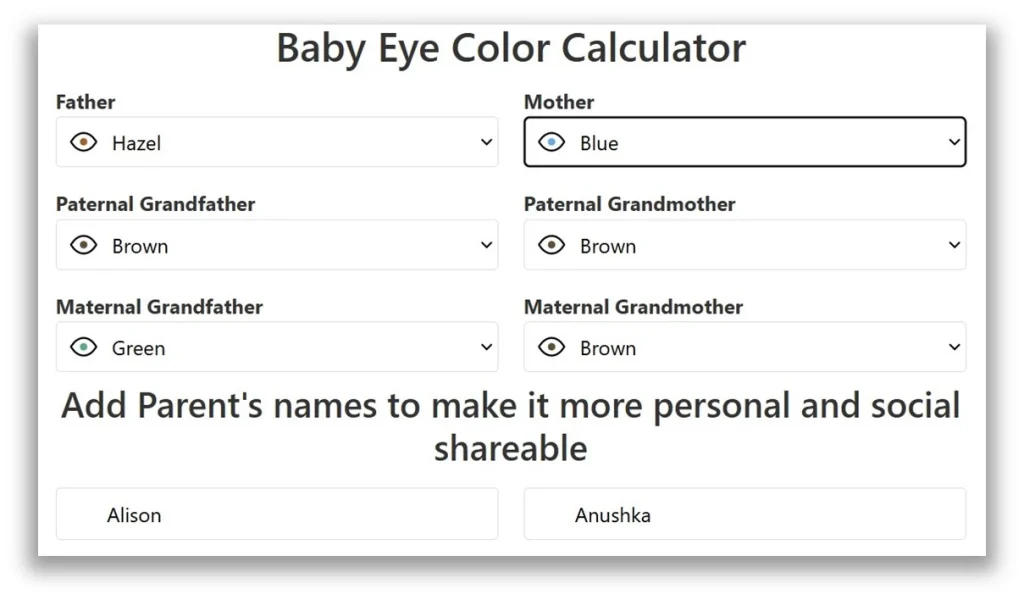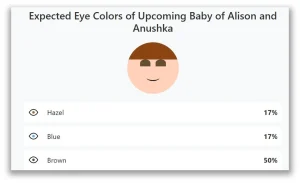Baby Eye Color Calculator
Curious about your furture baby’s eye color? Our Baby Eye Color Predictor Tool which utilizes the principles of Punnett Squares and gives you a glimpse into genetics, combining eye colors from both parents and grandparents to calculate the probability of various eye colors in your little one. Whether brown, blue, green, or hazel, discover the likelihood of each shade with this science-backed, interactive tool—designed to make eye color prediction easy, accurate, and fun for parents!
Color of Baby's Eye Calculator
How to Use This Eye Color Calculator
 Our Eye Color Predictor Tool makes it easy to explore the potential eye colors for your baby with just a few quick steps. Follow these instructions to see the magic of genetics unfold!
Our Eye Color Predictor Tool makes it easy to explore the potential eye colors for your baby with just a few quick steps. Follow these instructions to see the magic of genetics unfold!
Step 1: Enter Parents’ and Grandparents’ Eye Colors
The tool’s interface is designed to be user-friendly, helping you enter information quickly. Start by selecting eye colors for both parents. At the top of the calculator, you’ll find two input fields where you can choose the eye color of the baby’s father and mother. Beneath these, you’ll see additional fields for the paternal grandparents—the father’s parents—where you can add eye colors for the baby’s grandfather and grandmother on the father’s side. Similarly, the next two fields allow you to enter eye colors for the maternal grandparents (the mother’s parents). If you’re unsure about any grandparent’s eye color, simply select the “Don’t Know” option. This flexibility allows the tool to factor in as much information as you can provide, for the most accurate prediction.
 Step 2: Personalize by Adding Parent Names
Step 2: Personalize by Adding Parent Names
One unique feature of this calculator is the option to personalize the results by adding the names of the baby’s parents. This field is optional, but it allows you to create a customized result. If you choose to add names, they will appear in the final report, making it more personal and memorable. This is especially useful if you want to download the results as an image for keepsakes or to share with friends and family on social media. Including the names adds a personal touch to your prediction experience, making it both fun and meaningful!
Step 3: Generate Results
After entering all the details, simply click on the “Calculate Probabilities” button to see the results. The tool will analyze the eye colors entered for the parents and grandparents, combining the genetic factors to provide a probability chart. The chart will showcase the possible eye colors for your baby, featuring a title that includes your name and your spouse’s name if entered. This step provides an instant look at the beautiful range of potential eye colors for your child based on genetic possibilities.
Step 4: Download or Share Your Prediction
Once you have the results, you can choose to download them as a high-quality image or share them directly on social media. The image format makes it easy to save your prediction as a keepsake or share with family and friends, so everyone can join in the excitement. This final step gives you the flexibility to store, print, or post your eye color prediction in a way that’s both memorable and shareable!
Moreover, if you are interested in a complete genetics calculation of your upcoming baby, you should use our Baby Genetics Calculator which can estimate probabilities of other traits such as hair color, skin tone, blood type and many more.
How Eye Color is Inherited in Offsprings
To understand eye color calculation, start with the basics of genetics. Early studies on inheritance suggested that eye color follows simple genetic rules: brown is a dominant trait, and blue is recessive. In this model, a brown-eyed parent would typically pass on their brown-eye gene to the child. However, eye color is far more complex!
Today, we know that multiple genes influence eye color, and they can interact in surprising ways. Scientists now classify eye color as a polygenic trait, meaning several genes combine to determine it. This is why two brown-eyed parents may have a blue-eyed child. Also, hazel, green, and gray shades appear in families with both blue and brown eyes.
Moreover, each parent contributes half of the genetic material that determines the baby’s traits, including eye color. These genes create a unique combination, making every prediction an exciting possibility.
What Determines Eye Color in Babies?
When predicting eye color, two genes stand out: OCA2 and HERC2. These genes play a big role in how much melanin—the pigment responsible for color—is present in the iris. Melanin not only gives color to eyes but also to skin and hair, linking these features genetically.
- OCA2 gene: This gene influences melanin production. Higher melanin levels produce darker eyes (like brown), while lower melanin levels lead to lighter colors (such as blue).
- HERC2 gene: This gene controls the OCA2 gene. When HERC2 reduces the OCA2 gene’s activity, melanin levels drop, resulting in blue or light-colored eyes.
Other genes contribute to eye color variety as well. For instance: - SLC24A4 and TYR: These genes affect melanin pathways, adding unique shades like green and hazel.
By analyzing these genes and their interactions, we can create a model that estimates eye color more accurately than ever.
How Melanin Shapes Eye Color in the Iris
The color of our eyes depends on melanin levels and distribution in the iris. Here’s how it works:
- High melanin levels lead to darker eye colors, like brown and dark hazel.
- Low melanin levels result in lighter shades, like blue and gray.
However, it’s not just about how much melanin is present; it’s also about how it’s distributed. Variations in melanin density create shades such as green and hazel, where small amounts of pigment mix with light reflection to produce unique colors.
Most babies are born with blue or gray eyes because their bodies haven’t produced much melanin yet. Over time, melanin production increases, and eye color may shift, sometimes dramatically, until about age three. Our “Child eye color calculator” considers these melanin influences when calculating eye color probabilities.
Probability of Eye Color Inheritance
The Color of baby’s eye calculator uses genetic probability to give you an estimate of your baby’s eye color.
The process starts with the Punnett Square method, a classic way to predict inherited traits by mapping out dominant and recessive alleles (gene variants). However, because eye color involves multiple genes and combinations, our tool goes beyond this basic model to give you a more nuanced prediction.
To improve accuracy, our tool also factors in grandparents’ eye colors. Here’s why this matters: grandparents may carry recessive genes that aren’t visible in the parents’ eye colors. For example, if both parents have brown eyes but carry a hidden blue-eye gene from a grandparent, there’s a chance their child could have blue eyes.
In short, the more family eye color data you provide, the better the tool can estimate your baby’s likely eye color, blending traditional Punnett Squares with modern genetic knowledge.
Why Family Eye Colors Matter in Prediction
Including grandparents’ eye colors adds an extra layer of insight. Eye color inheritance can be unexpected, even when both parents share the same eye color. When you add grandparents to the mix, you’re accounting for hidden genetic factors that might not show in parents’ eye colors but can still influence the baby’s eye color.
For example, here are a few common inheritance scenarios:
- Two brown-eyed parents: While brown is dominant, if both carry a recessive blue gene, there’s a chance for lighter-colored eyes.
- One brown-eyed parent and one blue-eyed parent: Brown is more likely, but blue could also appear depending on the genetic combination.
- Two blue-eyed parents: Usually, two blue-eyed parents will have blue-eyed children, but green or hazel may also be possible due to polygenic influences.
By combining the eye colors of both parents and grandparents, our eye color calculator tool considers these potential recessive traits, helping you see the range of possible outcomes.
Why Babies’ Eye Colors Change Over Time
Most babies are born with blue or gray eyes due to low melanin levels. During infancy, melanin production increases as the eyes adapt to light exposure. This can lead to noticeable changes in color within the first few months. By the time a child reaches age three, their eye color usually settles into its permanent shade.
Sometimes, subtle shifts in eye color may occur throughout life. Factors like age, overall health, and even environmental influences can subtly alter the intensity or hue of eye color, though usually not the base color itself. These changes are often minimal but can be fascinating to notice over time.
Eye Color Prediction Chart
An eye color prediction chart is a simple, visual way to estimate the likely eye colors a baby might inherit based on their parents’ eye colors. The chart organizes probabilities into a grid, showing how different combinations of parental eye colors—like brown, blue, and green—can lead to a range of outcomes. By using basic genetic principles, the chart helps parents understand the potential distribution of eye colors, from the most common shades to less frequent ones. Lets take a look at the following chart:
| Parent 1 Eye Color | Parent 2 Eye Color | Probability of Brown Eyes in child | Probability of Blue Eyes in child | Probability of Green Eyes |
| Brown | Brown | 75% | 6% | 19% |
| Brown | Blue | 50% | 50% | 0% |
| Brown | Green | 50% | 12% | 38% |
| Blue | Blue | 0% | 99% | 1% |
| Blue | Green | 0% | 50% | 50% |
| Green | Green | 0% | 25% | 75% |
Eye color inheritance is influenced by multiple genes, with brown typically being a dominant trait, while blue and green are recessive. This means that even if both parents have brown eyes, there’s a small chance of blue or green eyes if they carry recessive genes. The prediction chart captures this complexity by showing a likelihood for each color based on dominant and recessive interactions, making it an accessible tool to visualize genetic probabilities without needing advanced genetics knowledge.
While a traditional eye color prediction chart provides useful estimates, it’s important to remember that genetics can be surprising! Eye color is a polygenic trait, meaning it’s influenced by several genes working together. By including information from grandparents’ eye colors, the chart becomes even more insightful, helping to account for hidden genetic traits. This makes it an exciting, easy-to-use way for families to explore the beautiful spectrum of eye color possibilities that genetics can produce.
